-
Marko Rillo wrote a new post 10 years, 4 months ago
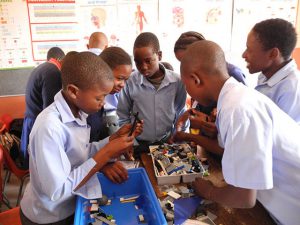 Schoolkids playing with legos. From: fastcoexist.com
Schoolkids playing with legos. From: fastcoexist.comFast Co Exist has published this article about the linkages between Lego and creativity.
By: Jessica Leber
Creativity is in decline around the world. But a new school built by the toy block company that focuses on play might unlock the secret to a solution.
If successful companies and societies of this next century are defined by their ability to innovate–a trope repeated constantly in business seminars, surveys, and speeches–then the U.S. may be headed for a rough time: On average, Americans’ ability to think creatively has declined.
This trend has been called “the creativity crisis,” and was defined by a major study in 2011. Researchers looked at a common measure of creativity in 300,000 kids and adults over time and found that, unlike IQ scores, creativity had been declining since 1990. The effect was most marked in elementary-school-age kids.
Why exactly creativity measures are declining is still anyone’s guess, although evidence and intuition points to the growing emphasis on testing in education as a factor. Kids are taught to learn by understanding “the one right answer” they need to find, and what they need to do to find it. (On tests of how kids do at brainstorming ideas, 98% of three-year-olds register as “creative geniuses.” By the time they are 25? Only 2%).
“There’s an immense and growing pressure to be able to standardize approaches in the school to ensure quality. And this is an interesting contradiction, because standardization never leads to quality when we talk about learning. We’re not producing products. We’re trying to educate children,” says Randa Grob-Zakhary, CEO of the Lego Foundation.
The foundation, endowed by the Lego Group, is now focused on revamping education systems to try to shift this dynamic at all ages–mainly by incorporating structured, hands-on “play” that fosters creative thinking. “A lot of work is focused on how can we better teach and more quickly teach reading and math–literacy and numeracy,” she says, speaking with Co.Exist at the United Nations’ Global Compact summit in New York City last month. “There’s still a very big gap in defining how can we better equip our children with creative and critical thinking skills to equip them to face tomorrow’s challenges.”
Last month, the Lego Foundation opened its own international school in Billund, near the company’s headquarters in Denmark, where the foundation will attempt to rigorously test and measure some of these ideas by incorporating “hands-on learning” into the curriculum wherever possible–with Lego bricks, but also with other toys, building materials and even robotics technologies. The school will build on the work of the foundation’s existing projects around the world. One, in South Africa, is where today 40,000 kids in grades K to 12 at 25 schools are working with a curriculum that includes play. Anecdotal evidence from this project shows that tests scores have gone up and teacher turnover has been “transformed,” says Grob-Zakhary, though no rigorous studies have been done.
She envisions a key role for the foundation in building a network that moves educational and psychological research on the topic of play and creativity out of academic journals and into the hands of teachers and policymakers. She is also looking to attract buy-in from the business world, which often invests in workforce training in college programs but rarely focuses on early childhood.
She believes that businesses need to start taking a longer-term view. “If we don’t start in those first five years, we have much less possibility to create that workforce we need. And yet very few businesses who would benefit from that kind of agility and adaptiveness built in the early years actually invest in it. It’s a really significant issue.”
-
Marko Rillo wrote a new post 10 years, 4 months ago
Sjra Puts has produced an exciting action trailer about Lego Serious Play in progress. Enjoy! :-)
-
Marko Rillo wrote a new post 10 years, 4 months ago
31Volts is a young and experienced service design agency based in the Netherlands who work in the overlap of business and creativity. They have recently posted a video of one of their Lego Serious Play sessions to Vimeo
-
Marko Rillo wrote a new post 10 years, 4 months ago
Students’ Union of the University of the Arts London published a short case on Managing Stuckness with Lego Serious Play
So, apparently Lego Serious Play (LSP) is an actual thing. I signed up to this
-
Marko Rillo wrote a new post 10 years, 4 months ago
Catherine Ryan, who calls herself “High Priestess of Human Experience Design at hEx Studios” has produced a visually entertaining and interesting slideshare where she presents co-creation coupled with the Lego Serious Play methodology.
-
Marko Rillo wrote a new post 10 years, 4 months ago
LSP Bricks Available Online
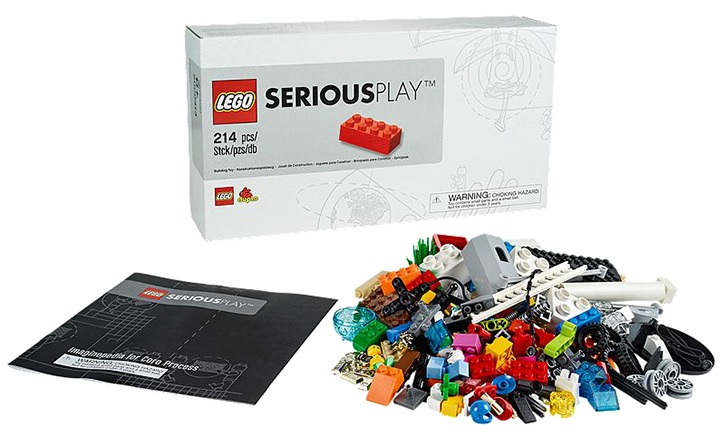 Now you can directly order all four LEGO SERIOUS PLAY kits directly via LEGO Online Shop: – Lego Serious Play Set of 100 Exploration Bags (2000409) –
Now you can directly order all four LEGO SERIOUS PLAY kits directly via LEGO Online Shop: – Lego Serious Play Set of 100 Exploration Bags (2000409) – -
Patrizia Bertini wrote a new post 10 years, 4 months ago
-
Marko Rillo wrote a new post 10 years, 4 months ago
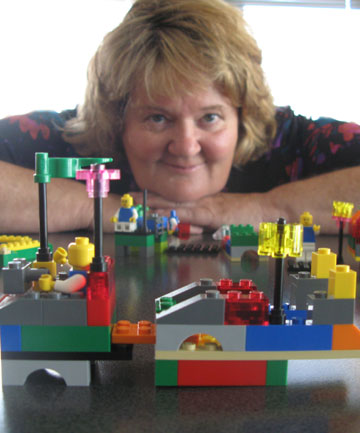 Central Otago WasteBusters manager Glenys Byrne gets adults to use their imagination with Lego Serious Play.
Central Otago WasteBusters manager Glenys Byrne gets adults to use their imagination with Lego Serious Play.JO MCKENZIE-MCLEAN
A Central Otago waste manger is proving lego isn’t just for children. Glenys Byrne, general manager of Central Otago WasteBusters, held a Lego Serious Play (LSP) workshop earlier this month with a group of people from WasteBusters and the Central Otago District Council, including councillor Clair Higginson and Bernie Scurr from health and safety.
Byrne said she was one of only a few facilitators nationwide trained to hold the LSP workshop, which was designed to enhance business performance through building with lego bricks. LSP had been used by organisations such as Nasa and Coca-Cola, she said.
“The bricks allow people to think freely, and express themselves as they create, the process is not reliant on the typical verbal jousting that goes on in meetings, or filling up a blank page, instead, participants use a carefully chosen selection of bricks and a unique process where people ‘think through their fingers’ – unleashing insight, inspiration and imagination.”
There was a bit of head-scratching around the table when the group was asked to create something out of lego bricks to reflect a sustainable future in Central Otago. However, with only five minutes to complete the task, the participants quickly starting building wind turbines, vegetable gardens, electric cars, solar-powered homes and wind operated irrigation systems.
Higginson said the workshop was insightful and challenged them to use their own creativity, work in pairs and then share their visions as a group: “I found the hands-on part of it helped get over anxieties we may have had in speaking up in the group.” Scurr said the exercise reinforced how different everyone was and how differently everyone thought.
Source: http://www.stuff.co.nz/southland-times/news/9969808/Councillors-get-serious-about-building-blocks
-
Arno Bendermacher uploaded a new picture: Ipad 2-140511 077.P… 10 years, 4 months ago
-
SEMEI CASTILLO uploaded a new picture: Asi empezo LSP en m… 10 years, 4 months ago
-
Alberto posted an update 10 years, 5 months ago
Now I am certified in CANVAS with Lego Serious Play methodology. Thanks Per for the certification. It was excellent and very powerful. I am proud to be part of the first certification in the world
-
Pierre-Yves Maniquet posted an update 10 years, 5 months ago
Just surviving the certification program LSP :-)
Very powerful ! -
Dr Abeer Pharaon posted an update in the group
 Serious Play Forum 10 years, 5 months ago
Serious Play Forum 10 years, 5 months agoHow would you deliver LSP taster session in 3 hours? anyone had similar experience?
-
hi Dr. Abeer,
How many participants will be there? Depending on the number and your goal, you can try different exercises.
Always begin with the tower/bridge challenge. And then move towards discovering the metaphore.
You can try with the duck building if you want them to understand the particularity of each participant. Or you can try the…[Read more]
-
Many thanks Patricia
I will have about 25-30 people for 1 hour
any ideas?
thanks for the reply
-
-
As Patricia has already pointed out – there are lots of different applications out there for short interventions. It depends greatly on your location, the type and size of your group. If you would fill us in about whom do you plan to deliver the taster session then we would be happy to brainstorm with you how to make it work.
-
Many thanks Marko
I will have about 25-30 people for 1 hour
any ideas?
thanks for the reply-
Hi, Dr. Abeer. Not too much time. It’s always important to help the group get used to the bricks, through building the tower or the bridge. Then, you might make them build a free model and one of the models from the booklet. And that’s almost it, with an hour.
Good luck!
-
With this size of a group and this amount of time I would give a short introduction and make every person play with the contents of a window exploration bag. You can choose to put people in groups of 4/5 and make them do some small excercises like building a tower to experience ownership, building small metaphors using a same starting point and do…[Read more]
-
Am with Wiro on this. in one hour, do a quick tower, followed by the explain this, and then something a bit personal or relevant to the theme. Make certain you have time, 15 min or so for a bit of discussion and sharing of how LSP works in companies
-
-
-
-
The Think With Your Hands workshop was designed to be a 3-hour experience, based on seeing groups get a lot out of the smaller format:
http://www.thinkwithyourhands.com .but in one hour, there are more impactful LEGO interventions (not really LSP) – the innovation ducks are always a winner; and I have heard great reviews of Per’s presentations at the…[Read more]
-
Hi Jody
Would be grateful if you would allow sharing your video and possibly more info about the think with your hands content
thank you
-
-
Quick reply, the approach I have used at Pegasus and other conferences is a robust skills building followed by a relevant AT1 challenge, and then a bit of supporting theory and finally case examples.
It is very much following the experience – explain principle
Happy to share more, if or when needed-
Thanks Per, Do you have further info re the Pegasus conference or any further information for short LSP introductory sessions
thanks
abeer
-
-
-
Lesa Nichols posted an update 10 years, 5 months ago
I am staying very busy making a business plan for my company, LSP workshops (little ones) and working with my clients. Soon, I will be planting flowers also.
How about you? -
Marko Rillo wrote a new post 10 years, 5 months ago
Reinhard Ematinger has published an interesting radio interview about Lego Serious Play on Vimeo
-
Marko Rillo wrote a new post 10 years, 5 months ago
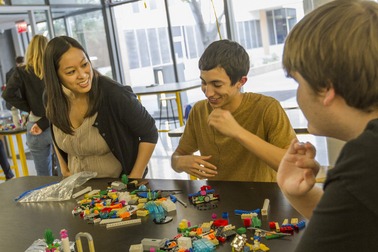 Engineering professor Candace Chan, a nanoscientist, checks in with undergraduate students Ruben Hernandez (aeronautics major) and Dylan Baker (mechanical engineering major) as they work on their LEGO models
Engineering professor Candace Chan, a nanoscientist, checks in with undergraduate students Ruben Hernandez (aeronautics major) and Dylan Baker (mechanical engineering major) as they work on their LEGO modelsFrom: (Nanowerk News) Students at Arizona State University are learning how to play.
ASU undergraduates have the opportunity to enroll in a challenging course this fall, designed to re-introduce the act of play as a problem-solving technique. The course is offered as part of the larger project, Cross-disciplinary Education in Social and Ethical Aspects of Nanotechnology, which received nearly $200,000 from the National Science Foundation’s Nano Undergraduate Education program.
Engineering professor Candace Chan, a nanoscientist, checks in with undergraduate students Ruben Hernandez (aeronautics major) and Dylan Baker (mechanical engineering major) as they work on their LEGO models during a Feb. 24 pilot workshop.
The project is the brainchild of Camilla Nørgaard Jensen, a doctoral scholar in the ASU Herberger Institute’s design, environment and the arts doctoral program. Participants will use an approach called LEGO Serious Play to solve what Jensen calls “nano-conundrums” – ethical dilemmas arising in the field of nanotechnology.
“LEGO Serious Play is an engaging vehicle that helps to create a level playing field, fostering shared conversation and exchange of multiple perspectives,” said Jensen, a trained LEGO Serious Play facilitator. “This creates an environment for reflection and critical deliberation of complex decisions and their future impacts.”
LEGO Serious Play methods are often used by businesses to strategize and encourage creative thinking. In ASU’s project, students will use LEGO bricks to build metaphorical models, share and discuss their creations, and then adapt and respond to feedback received by other students. The expectation is that this activity will help students learn to think and communicate “outside the box” – literally and figuratively – about their work and its long-term societal effects.
Jensen works with a team of faculty members, including Thomas Seager, an associate professor and Lincoln Fellow of Ethics and Sustainability in the School of Sustainable Engineering and the Built Environment, one of ASU’s Ira A. Fulton Schools of Engineering; Cynthia Selin, an assistant professor in the School of Sustainability and the Center for Nanotechnology in Society, housed at the Consortium for Science, Policy and Outcomes at ASU; and Mark Hannah, an assistant professor in the rhetoric and composition program in the ASU Department of English, College of Liberal Arts and Sciences.
Fifteen engineering students enrolled in the Grand Challenge Scholar Program participated in a Feb. 24 pilot workshop to test project strategies. Comments from students included, “I experienced my ideas coming to life as I built the model,” and “I gained a perspective as to how ideas cannot take place entirely in the head.” These anecdotal outcomes confirmed the team’s assumptions that play and physical activity can enhance the formation and communication of ideas.
“Technology is a creative and collaborative process,” said Seager, who is principal investigator for the grant. “I want a classroom that will unlock technology creativity, in which students from every discipline can be creative. For me, overcoming obstacles to communication is just the first step.”
Seager’s work teaching ethical reasoning skills to science and engineering graduate students will help inform the project. Selin’s research on the social implications of new technologies, and Hannah’s expertise in professional and technical communication will facilitate the dialogue-based approach to understanding the communication responsibilities of transdisciplinary teams working in nanotechnology. A steering committee of 12 senior advisers is helping to guide the project’s progress.
“Being a new scientific field that involves very complex trade-offs and risk when it comes to implementation, the subject of ethics in nanoscience is best addressed in a transdisciplinary setting. When problems are too complex to be solved by one discipline alone, the approach needs to go beyond the disciplinary silos,” said Jensen.
The ASU project will leverage LEGO Serious Play’s promised “systematic creativity” in an immersive nanotechnology environment, which the team believes is a natural fit because of its micro-to-macro scale and its hands-on approach to experiential learning and deliberation.
“As we train the next generation of students to understand the opportunities and responsibilities involved in creating and using emerging technologies that have the potential to benefit society, we need to advance our capacity to teach diverse stakeholders how to communicate effectively,” said Jensen.
Source: Arizona State University
-
HECTOR CANCHOLA commented on the post, Lego Serious Play Facilitation Training in Spanish 10 years, 5 months ago
Hola!
Me interesa mucho participar en el evento de México!, por favor contáctenme para conocer los requisitos!
saludos! cabah_82@hotmail.com -
Anggela commented on the post, LEGO® SERIOUS PLAY™ Facilitator Training in Spanish 10 years, 6 months ago
Lucio estoy interesada en el entrenamiento en Perú, somos un equipo de 05 personas favor de contactarse.
-
Juan Carlos Campos posted an update 10 years, 6 months ago
Tenemos ya programados 25 workshops mas!!
-
Juan Carlos Campos uploaded a new picture: mención honorifica … 10 years, 6 months ago
- Load More

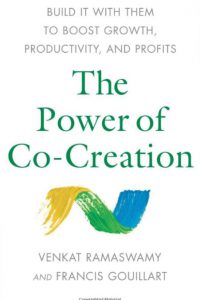
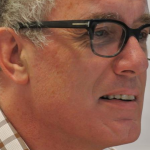
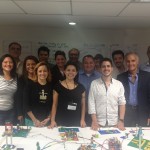
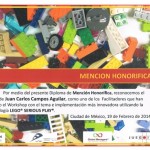

 Become a LEGO Serious Play facilitator - check one of the upcoming training events!
Become a LEGO Serious Play facilitator - check one of the upcoming training events!
It is really awesome!!!!
Thank you Luca and thank you Marko for posting the trailer!